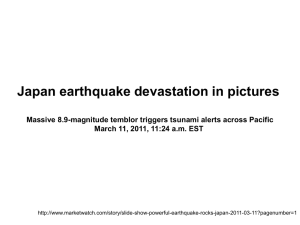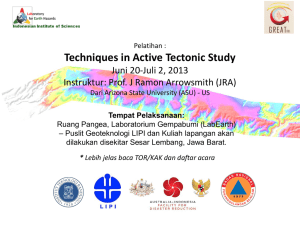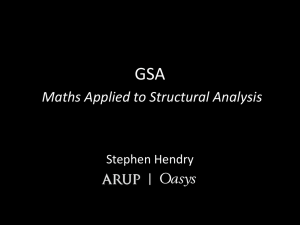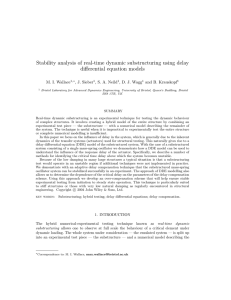Experimental Assessment of Coastal Infrastructure Vulnerability
advertisement
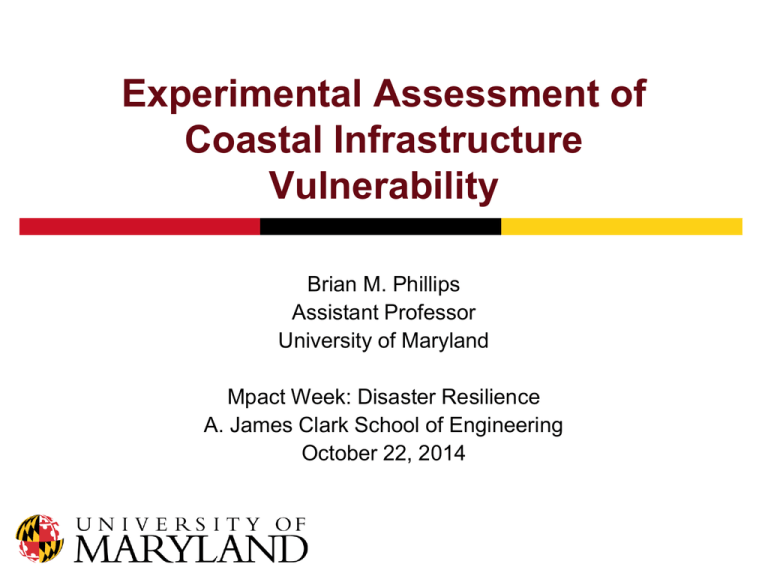
Experimental Assessment of Coastal Infrastructure Vulnerability Brian M. Phillips Assistant Professor University of Maryland Mpact Week: Disaster Resilience A. James Clark School of Engineering October 22, 2014 INTRODUCTION AND MOTIVATION 2 Experimental Testing Experimental testing required when Response complex or not well understood Difficult to model numerically Models do not exist Results lead to better Understanding of dynamic behavior Computational models and constitutive relationships Design methods and codes 3 Advances through Recent Investments in Experimental Testing Performance-based design and real-time, large-scale testing to enable implementation of advanced damping systems -PI Shirley Dyke (Purdue) Created high-fidelity numerical models Developed structural control devices and algorithms Validated of performance based design approach Role of Experimental Testing in Impact Assessment 5 S.L. Lin, J. Li, A. S. Elnashai, and B. F. Spencer (2012). “NEES Integrated Seismic Risk Assessment Framework (NISRAF),” Soil Dynamics and Earthquake Engineering, Vol. 42, pp. 219-228. EXPERIMENTAL METHODS 6 Experimental Methods Quasi-Static Testing Validate new components and materials Wave Tank Study tsunami flow, impact, debris, and scour Oregon State University Tsunami Wave Basin University of Illinois Large-Scale Reaction Wall Hybrid Simulation Efficiently combine experimental testing and simulation Shake Table Testing Study performance of structures under severe earthquake loads Univ. of California San Diego Large-Scale Shake Table 7 Multi-Site NSF Project Dynamic Testing Summary Shake Table Real-time Hybrid Simulation x2 x2 x1 Effective Force Testing x2 f 2 m2 xg xg1 x g f 2 f1 f1 m1m xg Experimental Input Base acceleration Numerical Simulation Not required Dynamic Experiment Yes Substructuring Not possible Experimental Input Story displacements Numerical Simulation Required Dynamic Experiment Yes Substructuring Possible Experimental Input Story inertial forces Numerical Simulation Not required Dynamic Experiment Yes Substructuring Possible 8 Substructuring Structure of Interest Actuators Numerical Substructure Sensors Experimental Substructure 9 COASTAL INFRASTRUCTURE EXPERIMENTAL OPPORTUNITIES 10 Coastal Infrastructure Experimental Studies Wish list Substructuring Accurate, reproducible loading Use widely available equipment x2(t) m2 k2 c2 m1 k1 x1(t) c1 Multi-physics Numerical substructure Fluid-structure interaction Soil-structure interaction Impact forces Challenges Experimental substructure Wind Waves & Surge Complex boundary conditions Displacement compatibility Force equilibrium Earthquakes Flooding 11 Bridge Deck Uplift Kesen Bridge, Japan 2011 Tohoku Earthquake and Tsunami (Kawashima, 2011) Fluid-structure interaction test Gravity forces, Hydrodynamic forces FEM Model Deck and hydrodynamic load Displacements Specimen Elastomeric bearing 12 Saturated Soils and Scour Koizumi Bridge, Japan 2011 Tohoku Earthquake and Tsunami (EERI, 2011) St. John River, Maine 2008 (USGS) Fluid-soil-structure interaction test Gravity forces, Horizontal displacements Flow FEM Model Bridge superstructure Soil Restoring forces Specimen Submerged pier 13 Dynamic Soil Pressure Multiple failure mechanisms of New Orleans levees (NSF) East 26th Street, Baltimore April 30th, 2014 (Reuters) Soil-structure interaction test Forces Displacements FEM Model Soil, ground motion, and liquefaction Specimen Retaining wall 14 Hurricane Forces Prattsville, NY 2011 Hurricane Irene (FEMA) Union Beach, NJ 2012 Hurricane Sandy (FEMA) Fluid-structure interaction test Wind forces Displacements FEM model Building frame and hurricane winds Specimen Wind resisting system 15 Tsunami and Debris Impact Shin-Kitakami Bridge, Japan 2011 Tohoku Earthquake and Tsunami (Kawashima, 2011) 2004 Indian Ocean Tsunami (Palermo and Nistor, 2008) Fluid-debris-structure interaction test Tsunami forces, Impact forces Accelerations Forces Displacements FEM Model Tsunami simulation Specimen Moment resisting system FEM Model Upper stories 16 CONCLUSIONS 17 Conclusions Experimental testing has produced a revolution in earthquake engineering design and practice. Newly developed experimental testing techniques enable a wealth of studies for a similar revolution in coastal engineering. Multi-hazard testing Substructuring Dynamic force and displacement boundary conditions Direct force-based loads to specimens Highly interdisciplinary Flooding Earthquakes Waves & Surge Wind 18 Thank you for your attention References EERI (2011). “Geotechnical Effects of the Mw 9.0 Tohoku, Japan, Earthquake of March 11, 2011.” EERI Special Earthquake Report, September, 2011. Kawashima, K. (2011). “Damage of Bridges Resulted from March 11, 2011 East-Japan Earthquake”, Preliminary disaster survey, April 15. Palermo, D. and Nistor, I. (2008). “Tsunami-Induced Loading on Structures”, Structure, NCSEA/CASE/SEI, March. Lin, S.L., Li, J., Elnashai, A.S., and Spencer Jr., B.F. (2012). “NEES Integrated Seismic Risk Assessment Framework (NISRAF),” Soil Dynamics and Earthquake Engineering, Vol. 42, pp. 219-228. 19




